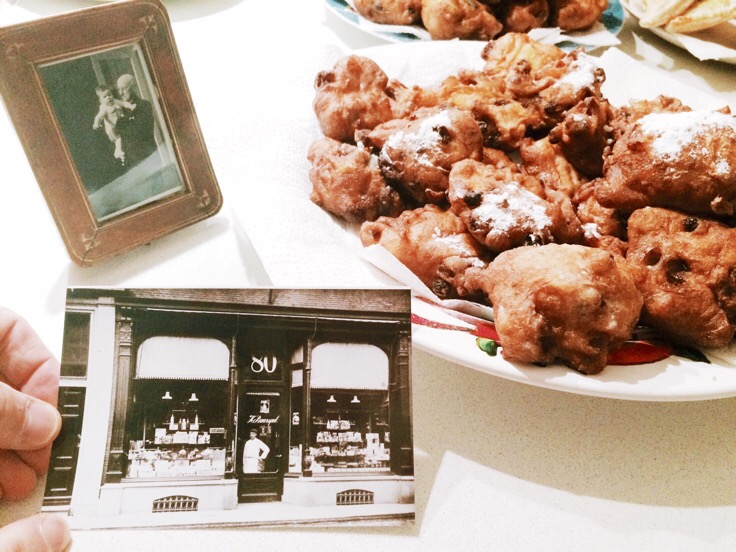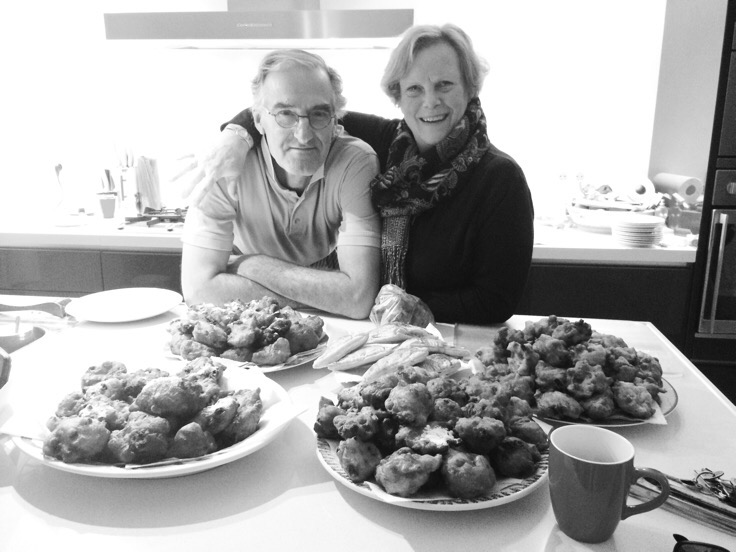“Fijne jaarwisseling,” says my neighbour Wim as he hands me and my son Bram Julius freshly made oliebollen – fried dough filled with raisins, apples, and currants, and then dusted with powdered sugar right before being served. And nothing else brings as much nostalgia and childhood memories of a Dutch New Year than oliebollen.
In the days leading up to New Year’s Eve, oliebollen are found everywhere – from seasonal stands, bakeries, and supermarkets. There’s even a nationwide competition to see who can bake the tastiest oliebollen. But the best, in my not-so-humble opinion, are always the ones made at home.
Bram Julius and I are in Wim’s and his wife Mariska’s kitchen to get an insider’s view on this beloved Dutch tradition. There are several pots on the stove filled with hot oil. The kitchen counter and island are littered with dozens upon dozens of oliebollen resting on cooling racks, or piled high on plates once they’ve cooled down. They bake over three hundred oliebollen to share among family, friends, and neighbours.
On the last day of the year for as long as he can remember, Wim starts getting everything ready at around 3:00 pm. Gradually different members of the family drop in to help here and there, lingering long enough to grab a bite of a freshly baked oliebol when they can. The scene is relaxed and joyful. The process of making all the oliebollen is a time of being together as a family, reflecting on the year they have had and looking forward to what awaits them in the coming one. It is gezellig – warm, cozy and intimate.
Wim inherited the oliebollen recipe from his uncle who once owned a bakery in Utrecht. Though the bakery has long closed, the memories and tradition are very much alive in his kitchen.
According to the article “The History of the Doughnut” in The Smithsonian magazine, oliebollen are considered the grandfather of American doughnuts. Dutch settlers in Manhattan, formerly known as New Amsterdam, introduced “olykoeks” or oily cakes to their fellow Americans. Supposedly, the name evolved to oliebollen – oily balls – because of their irregular round shape.
And no wonder they became an instant hit in the New World. Once you take a bite of the crispy outer shell, with the sugar melting in your mouth and the chewy textured center, chances are you’ll have a foodgasm.
Bram pulls at my sleeve, indicating for more.
“Just one more,” I say.
He runs over to Wim who already has one ready for him.
Finding Dutchland’s Olieballen Recipe
Ingredients
2 (0.6 ounce) packages of dried (instant) yeast
1/2 cup lukewarm milk
1 teaspoon sugar
4 cups all-purpose flour
1 1/2 cup lukewarm milk
1 teaspoon salt
1/4 cup sugar
2 eggs
1 cup dried currants
1 cup raisins
2 Granny Smith apples- peeled, cored and finely chopped
1 quart vegetable oil for deep-frying
1 cup confectioners’ sugar for dusting
Directions
In a small bowl, mix the teaspoon of sugar into 1/2 cup of warm milk. Sprinkle the yeast and wait for the concoction to bubble (may take up to ten minutes). Then stir in the mixture really well.
In a separate large bowl, sift the 4 cups flour, 1/4 cup sugar, and 1 teaspoon of salt. Make a hole in the flour mixture and add the 2 eggs, the yeast milk mixture and 1 1/2 cups lukewarm milk. Mix all ingredients well.
“Knead” the batter with a mixer at a high speed for 4 to 5 minutes.
Add the raisins, currants and apple. Mix well with a spoon, or the lowest setting of the mixer.
Cover the bowl with a moist towel or plastic wrap and place in a warm area for about 1 hour. The dough is ready when it is double the original size.
Preheat the vegetable oil in a deep-fryer, or a large pot for frying to a temperature of 180 degree Celsius.
Working in batches, use a metal ice-cream scooper (sprayed with oil so batter won’t stick) to form balls (6 cm). Gently drop them into the oil and bake for 5 minutes, turning them over halfway to cook thoroughly . They will appear golden and crispy.
Remove with a slotted spoon and place on a cooling wrack with a paper towel underneath to catch the excess oil.
Dust doughnuts generously with confectioner’s’ sugar and enjoy with caution (could be really hot and difficult to just have one).
Psst. Want to know why Dutch kids are the happiest in the world? Pre-order the UK edition of our book here:



